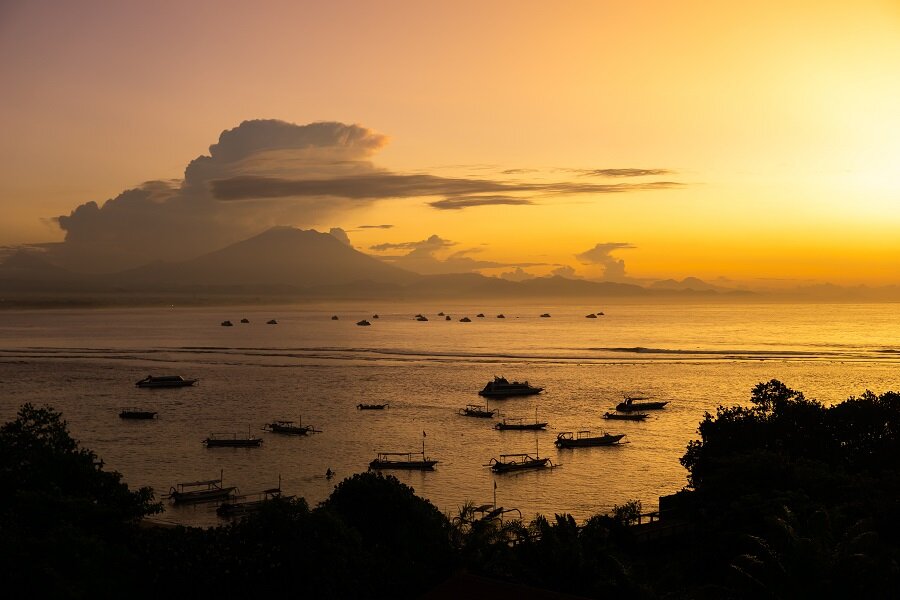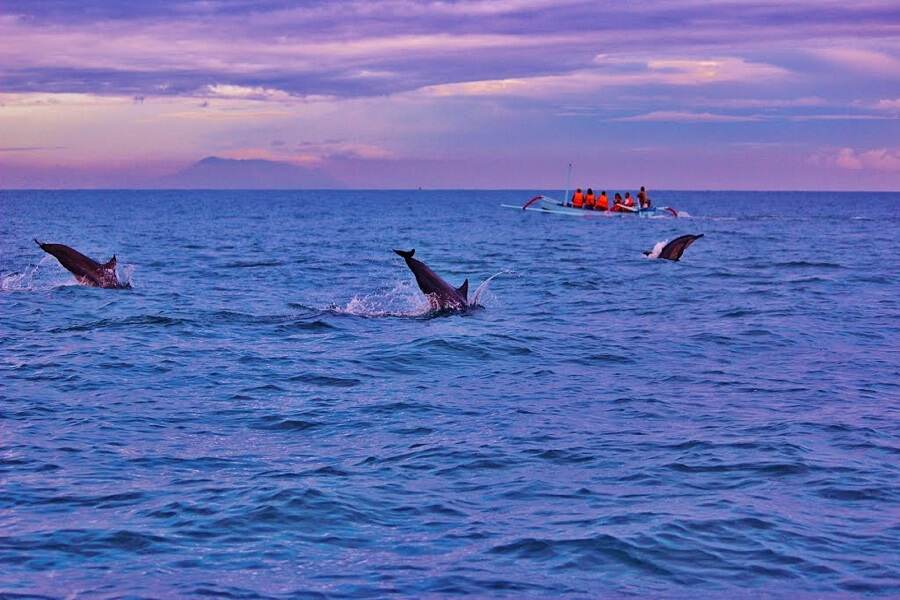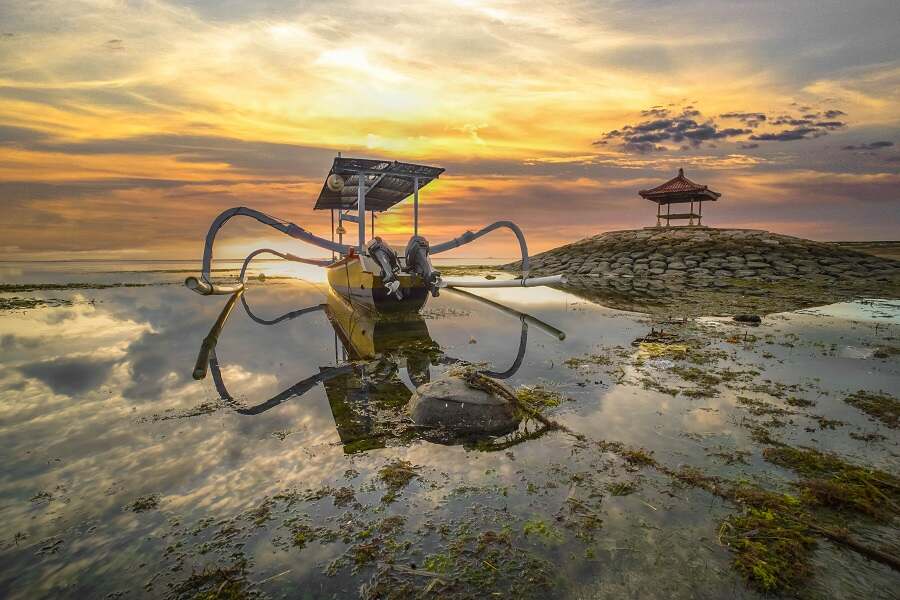Tides, Tales and Truths
Day 1: Coffee, Curves, and Cabernet
Dawn finds me on the soft white sands of Sanur, toes wiggling in the surf. I wander from the Meru shrine down to The Santrian’s open-air terrace, clutching a steaming kopi tubruk. “Happy morning!” the barista beams, as if we’re old friends. Around me, elders practice their slow-motion Tai Chi—Sanur life in slo-mo.
By 9 AM, the sea breeze whispers “go north!” Forget checklists. I hop into a rented Daihatsu, tunes switched from Dire Straits to Pavarotti & Friends, windows down, hair dancing in the wind. Google Maps is open but idle—this is spontan-e-ous travel.
My first serendipity: House of Sababay Winery at Saba village. A rustic tasting room perched above emerald vineyards. I sip a blush-pink “Pink Blossom” rosé with local goat cheese, watching Balinese wood storks glide overhead. “Just a sip,” I tell myself, pocketing two bottles for the road.
Cruising east along Jl. Ida Bagus Mantra, banyan-shaded curves paradise in motion. At noon I arrive at Padangbai’s Blue Lagoon, a sleepy diver’s hamlet. I climb to the hilltop restaurant “Laguna’s Outlook”—a 180° panorama of cerulean sea. Over a “Green Goddess” salad (avocado, beetroot, feta, greens galore) and freshly squeezed papaya-mint juice, I trade smiles with a local kid, Nyoman, who scavenges shells below. “Which shell is lucky?” I ask. He grins, plucks a spiral conch, and offers it as my talisman.

By mid-afternoon, I roll into Candi Dasa, that charmingly dozy village. No shops? No problem. I barter with a roadside stall for a bright sarong, a bikini top, and flip-flops—essentials of the spontaneous soul. My “hotel” is a tiny, turquoise-trimmed bungalow right on the black-pebble shore. Sunset finds me belly-flopped in the tide, sipping coconut water, as the sky blazes orange-pink. Dinner is a seaside BBQ: fresh snapper, prawns skewered over coconut coals, and the soft laughter of other guests.
Day 2: Fish Tales, Fiery Nets…and a Fisherman’s Faith
Morning light spills over Candi Dasa’s bay. I pad down to the fishing jetty, where Bu Wayan (a fisher’s wife) greets her husband returning from an all-night haul. “Banyak ikan!” she exclaims—hundreds of glinting fish tumbling onto the dock. Children dart among nets, gathering sprats for tomorrow’s breakfast. I buy two dozen, wrap them in banana leaves, and share them with my bungalow’s staff. “Makan ikan hari ini,” I promise, imagining the sizzle in their family kitchens.
I linger, watching the village pitch in—pulling boats ashore, blessing the catch, exchanging gossip. “In Bali, kindness is karma,” jokes Pak Ketut the fisherman, tossing me a wriggling mackerel. He raps my knee with a calloused fist, full of stories and sunburn.
But this morning’s laughter carries a shadow. Just a week ago, Pak Ketut’s neighbour, Wayan Suarta, sailed out in calm seas—only to be claimed by a sudden storm nobody saw coming. His boat capsized within minutes; no mayday call, just swirling waves and a frantic villagers’ prayer at the temple. Two days later, Wayan’s body washed ashore. The whole village gathered—children crying, fishermen in silent rows, women chanting by the shrine—to support his widow through the cremation rites. The temple courtyard overflowed with offerings: incense smoke rising like a bridge between worlds.
Does a tragedy like that decide your life’s direction? Here in Bali, it’s not catastrophe but faith that guides you. Pak Ketut shrugs as he mends his nets: “The sea takes, the sea gives—God’s will.” And with a nod to the sunrise, he pushes his boat back into the surf, trusting that every dawn is a promise renewed.
Day 3: Heritage, Huts, and Horizons
Mid-morning I point the car back east toward Taman Ujung, the Water Palace of Karangasem. Built in 1909 by King I Gusti Bagus Jelantik—who blended Balinese traditions with European elegance—the palace once served as a summer retreat for the royal family. Moss-choked statues gaze over lily ponds, and the echo of courtly laughter seems to linger in the marble corridors.
Wandering the gardens, I meet a distinguished gentleman, Dewandra Djelantik, the heir of the Jelantik line, accompanied by his graceful wife and two children who are just happened there for a ceremony – dressed well as a king, with his attribute representing the family heritage. Over coconut water beneath a frangipani, he speaks of ngelingahang leluhur—honouring ancestors—by restoring crumbling pavilions and reopening hidden groves to the public. “Preserving this place,” he says, “is our respect to those who came before us”. I learn on the important of heritage and preserving culture from within.
Half-hearted I continue onward along a narrow coastal road, not sure where to go as the road get slightly narrower and quieter. I pull over at a humble warung, then durian attract me- these weird looking fruits are calling. The villagers laugh as I gingerly bite into the custardy flesh—its aroma clinging to my fingers like an unshakeable promise. “Durian perfume,” one elder teases, handing me a palm-leaf napkin. Friendly and fun, safe surrounding, warung with a million-dollar view. Next, I crave a fresh coconut; a young man scales a slender coconut palm in seconds, drops me two coconuts with a grin, and sends me on my way—gratis, for a laugh shared.
Cliffs rise sheer beside the road, but Google Maps insists I’m on course for Amed. And sure enough, around a final bend, I gaze down on hundreds of colourful jukung—traditional outriggers—lined up like sentinels on the black-sand shore. These boats ferry divers to nearby reefs and shipwrecks, including the famous USAT Liberty, torpedoed in 1942 and now a thriving underwater garden a few kilometres north at Tulamben.
I choose the quirkiest homestay I can find—a bright Yellow Hut perched on the lava cliff’s edge.
That evening in Amed, I set out craving simple grilled fish, only to find myself in a chic Italian trattoria tucked along the black-sand road. One forkful of silky linguine with clams later—and a creamy gelato finale—I realized I’d strayed into a gastronomy adventure far from my original intent. The next morning, determined to reconnect with local life, I slipped into the humble warung next to my cliff-side hut.
Inside, Pak Gede—Balinese through and through, with a shy smile and a toddler son at his side—served me his signature ikan bakar (grilled snapper) over rice, sambal matah sizzling at the edge of the plate. Between bites, he confided how he worries each day whether his little warung can keep going, how the young generation drifts toward bigger towns and brighter lights. His gentle pride in cooking for travellers like me felt like a quiet act of devotion to tradition itself.
As I licked sambal off my fingertips, the scent of coconut oil and sea breeze reminded me that true adventure isn’t found in any menu’s price tag, but in the stories shared across the table—stories of struggle, resilience, and the timeless pulse of island life.
Before dusk, I join a group from a Bali Coral Restoration Project. Armed with hammers and coral fragments, we affix baby coral to metal “reefs,” hoping to coax life back to bleached reefs nearby. “This one’s named ‘Mimpi’—dream,” laughs Maya, our marine biologist. I promise to return in five years and swim among her nursery. Night falls over Amed, and in the hush I snorkel beneath my hut, phosphorescence trailing my fins. Dinner is spicy pepes ikan, eaten by candlelight. Sleep is a hammock lullaby, under a full moon, I reflect today’s trip with my wine glass against the railing, crank up “What a Wonderful World” on Spotify, and let Barry White’s voice mingle with crashing waves. Far from lonely, I feel cocooned by nature’s embrace…and then a hefty tokek (gecko) clatters across the wall. I leap up, slam the door—and laugh at myself for being such a coward. Damn.
Day 4: Dolphins, Deer, and Departures
Pre-dawn, I’m back on the road to Lovina—or “Loving-na,” as the locals affectionately call it—where the black sand shimmers like pulverized onyx under a pale moon. At the jetty, I meet Dewa, a wiry boatman whose laughter echoes over the water. “Siap, Bu? Bertemu dolphins!” he teases, handing me a battered binocular strap. As we glide into the glassy dawn, he points out his grandfather’s old nets hanging from the prow—“my family’s legacy,” he says softly, eyes on the horizon. Suddenly, a dozen sleek bodies break the surface in perfect unison. I gasp; Dewa whoops; and for a breathless moment, the world is nothing but dolphin spouts against the sunrise.

Passed Lovina beach I tapped on my shoulder as realizing I’ve essentially traversed Bali from tip to tip—far east to far west—sticking as close to the rugged north coast as I could. There’s still so much to see, and the best part is the freedom to pull over at any hidden waterfall—like that secret cascade near Les, where I dove into an emerald pool and emerged dripping joy.
By mid-day, my wardrobe was feeling as waterlogged as my swimsuit. So I detoured into Singaraja, Bali’s old capital, weaving through market stalls piled with batik shirts, sarongs, and souvenir trinkets. Nothing haute couture, but a bright sarong and a simple T-shirt will see me through the next few days in style.
Soon I was back on the coastal road, winding westward toward Menjangan Island and the larger Bali Barat National Park—a true conservation zone. At the little dock, Wayan, the park guide, greets me with a handful of sea snails for the resident deer. “They’re hungry,” he explains. We wade thigh-deep into the cerulean shallows, fins on, and slip into a kaleidoscope of clownfish, seahorses, and coral blooms. Surfacing, I hand Wayan more snails; he drops them near the shore where curious deer tiptoe forward, nuzzling the shells. A fawn nudges my knee, and I laugh—tender and surprised by its fearless warmth.
In Bali Barat National Park, patrol boats vigilantly monitor for illegal fishing while the coral restoration program cements new reef structures to revive bleached areas. Volunteers and rangers diligently tag and relocate sea turtle nests to protected hatcheries, ensuring the hatchlings are released safely into the surf. On land, Menjangan’s prized feral deer roam freely under a tagging system designed to keep their population in balance with the island’s lowland forest. And local children gather in guided “jungle classrooms,” where they learn firsthand about mangrove restoration, bird monitoring, and sustainable fishing practices.
On the boat ride back, I lean against the hull, salt drying on my skin, and marvel at how “being lost” can feel like coming home. As Bali’s coastline unfurls toward Sanur in the distance, I smile: tomorrow, I’ll tell these stories all over again.
The Return to Sanur: Philosophy in the Rear-View Mirror
Four days, zero strict plans, one island’s worth of serendipity. I roll back into Sanur as dawn kisses the palm fronds—tired, grateful, and achingly more alive.
Lost? Perhaps. But when the path is unwritten, every detour becomes discovery. Even with Google Maps, the heart charts its own way.

On Bali, “getting lost” isn’t misplacing your phone—it’s finding a story in every handshake, a lesson in every sunrise, and a slice of humanity at every roadside warung. And that, dear reader, is the greatest treasure of all.

